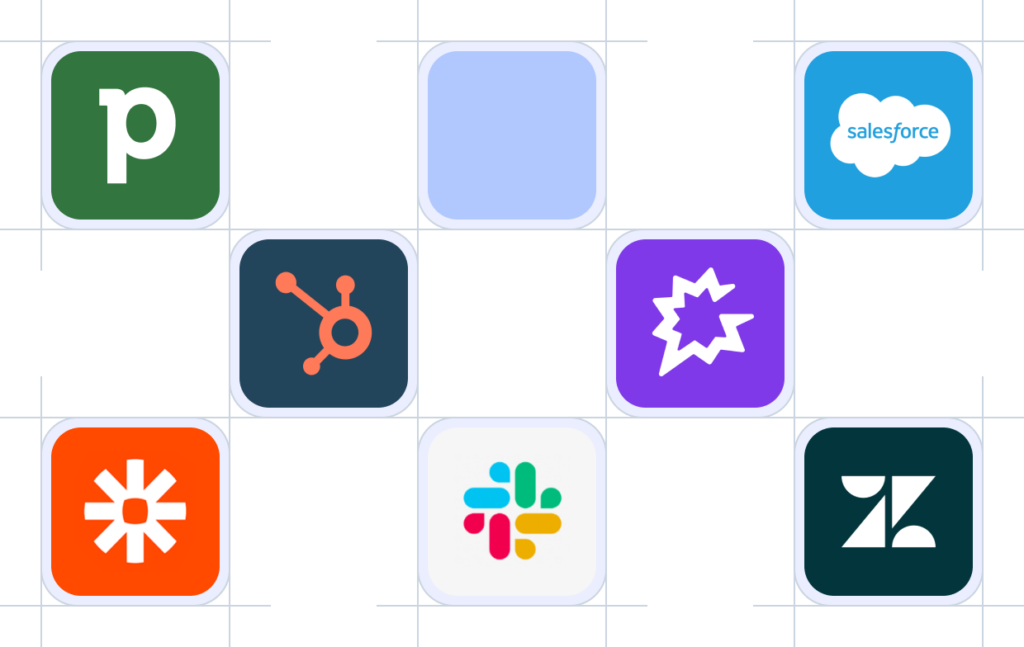- Solutions
- Solutions primary
- BY TEAM
- BY INDUSTRY
- BY USE
- BY SIZE
- Solutions secondary
- Let’s talk!
- Explore our business calling software
- Book a demo today
- Discover our integrations
- Turn CloudTalk into a much more powerful tool.
- Learn more
- Let’s talk!
- Solutions primary
- AI
- Features
- Integrations
- Integrations primary
- MOST POPULAR
- NEW
- first column
- second column
- Integrations secondary
- Let’s talk!
- Explore our business calling software
- Book a demo today
- Discover our integrations
- Turn CloudTalk into a much more powerful tool.
- View all integrations
- Let’s talk!
- Integrations list
- Integrations primary
- Pricing
- Resources
- Resources primary
- first column
- second column
- Resources secondary
- Book a demo today!
- Discover & access advanced features
- Schedule a demo
- Book a demo today!
- Resources primary
- Careers
Easily Create Automated Workflows
Let agents laser-focus on customers with contact center Workflow Automation. Fully automate repetitive or time-consuming tasks like follow-ups, ticket creation, and call transcriptions.
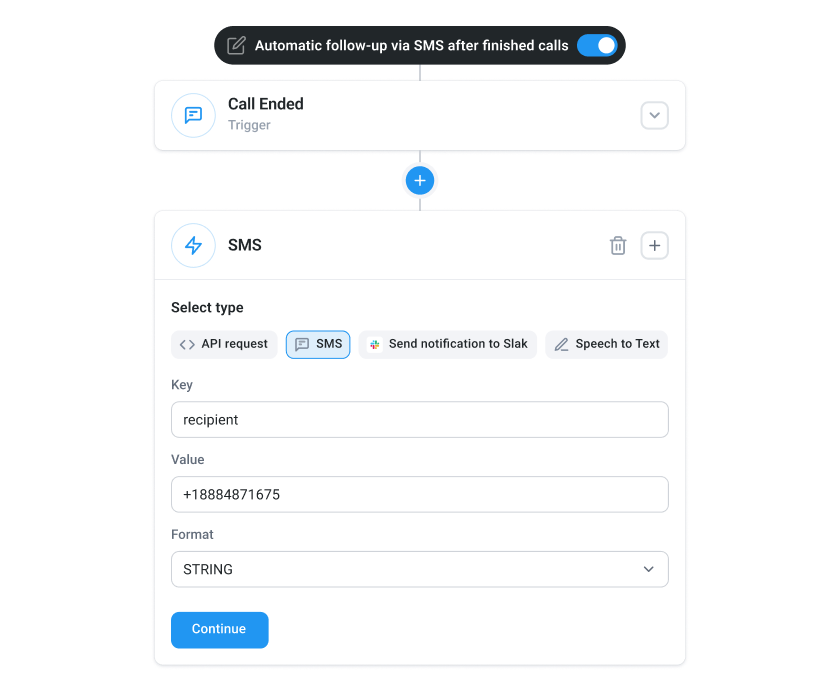
Focus on Tasks That Matter
Enjoy Easy Setup
Set up cloud workflow automations in three simple steps — Triggers, Conditions, Actions.
Eliminate Repetition
Automate repetitive tasks, for example follow-ups, and improve operational efficiency.
Adapt to Real Needs
Trigger actions based on customer responses or interactions to personalize service.
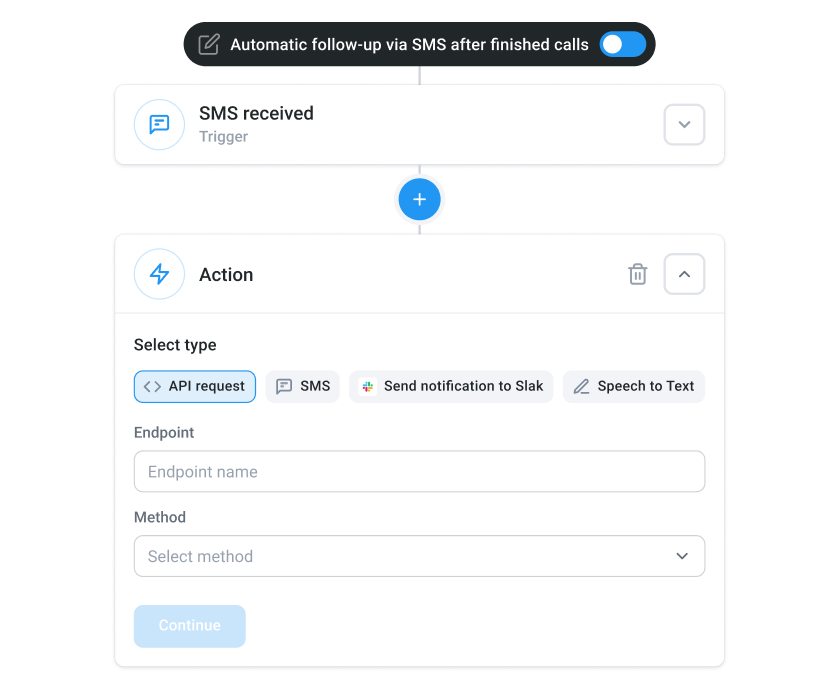
What is Workflow Automation?
Cloud-based Workflow Automation for customer support and sales teams streamlines your operations by automating routine tasks like call routing, follow-up reminders, and data entry. Instead of getting bogged down with repetitive processes, your team can focus on what truly matters—delivering exceptional customer service.
Examples of a Cloud Workflow Automation
Automated Ticketing for Customer Support
Streamline your customer support with automated ticketing systems that categorize and prioritize incoming requests based on urgency or topic. This ensures that critical issues are addressed promptly, enhancing customer satisfaction and reducing response times.
Lead Assignment Automation for Sales Teams
Automatically route your new leads to the right sales representatives based on various criteria like location, industry, or deal size. This not only speeds up the your sales process but also ensures that no opportunity slips through the cracks. Hit all sales KPIs.
Smart Call Routing for Call Center Operations
Automate call routing and direct customers to the most qualified agent, minimizing wait times and improving the overall customer experience. This targeted approach helps resolve issues more efficiently and keeps your team focused on high-value interactions.
Automated Follow-Up Emails for Customer Engagement
Lastly, automate follow-up emails after sales calls or support interactions. By sending personalized messages at the right time, you keep customers engaged and nurture leads without manual effort, driving conversions and building long-term relationships.
4 Benefits of Intelligent Workflow Automation
Increase Efficiency
Automate repetitive tasks such as sending follow-up messages, updating records, and notifying teams. Reduce the need for manual work and increase overall productivity.
Improve Accuracy
Ensures that tasks are executed consistently and without errors. Enhance your process reliability and data accuracy, leading to better decision-making and stellar customer service.
Save Time
Complete routine tasks faster by creating automated workflows. Free up valuable time for agents and managers, allowing them to handle more complex and value-added activities.
Engage Customers
Personalize your communications by sending follow-up emails and messages at the perfect time. Keep customers engaged, build stronger relationships, and drive convert more leads.
How to Automate Follow-Up SMS With CloudTalk
01
In the Dashboard menu, locate Account → Workflow Automation.
02
To automate follow-up SMS, use the trigger “Call Ended”.
03
Set up a condition to check if a tag field contains the expected tag.
04
Set up an action to send out required sms.
05
Press “Test” and fill out the testing information.
06
Save your workflow.
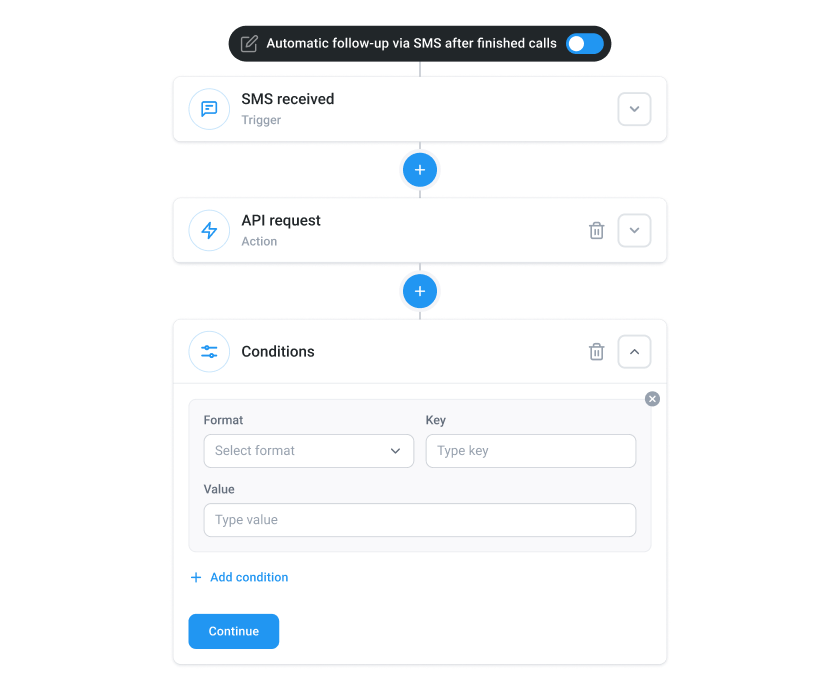
Automate your workflows now!

How to Automate Slack Messages With CloudTalk
01
In the Dashboard menu, locate Account → Workflow Automations.
02
To automate Slack Messages, use trigger SMS received.
03
Use conditions to filter incoming messages to only receive notifications for certain types of SMS. If not needed, do not add any conditions.
04
Use the action “Slack notification” to send a notification to Slack.
05
Add text messages that should be forwarded to a Slack channel. Make sure it contains all the required information from the trigger event.
06
Add other required information into empty field(s).
07
Press Test and fill out the testing information.
08
Save your Workflow.
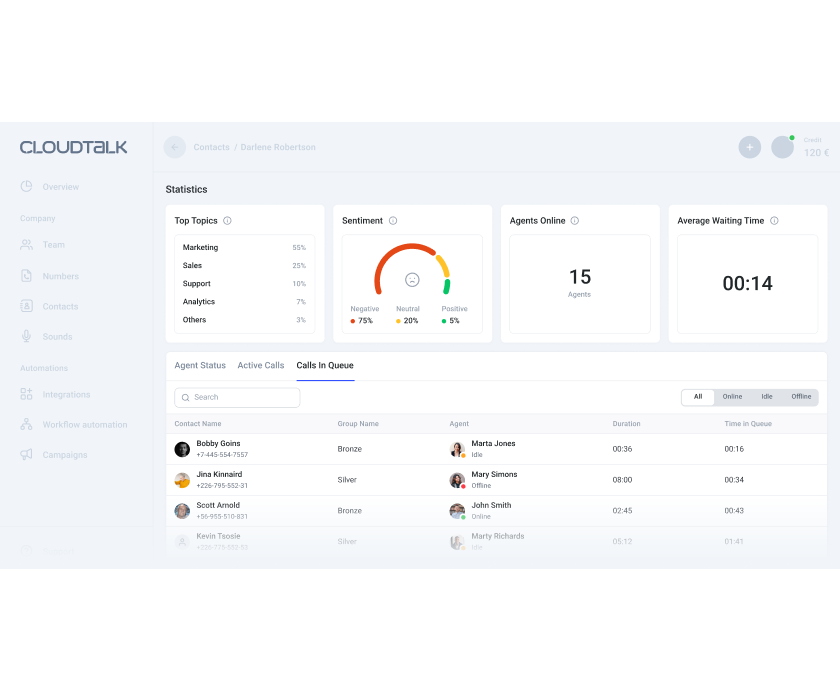
Other features you might like
Turn your CloudTalk into a much larger and powerful tool
Expand your business toolstack with a business calling software that can be easily integrated into your existing CRMs, ecommerce or helpdesk tools, like Salesforce, Freshdesk, Help Scout, and dozens more.
Have questions?
Why use Workflow Automation?
Cloud workflow automation helps businesses streamline their processes by automating repetitive and time-consuming tasks. This not only reduces human error but also speeds up operations, allowing teams to focus on more strategic and value-added activities. Additionally, it ensures consistency in task execution, enhances productivity, and ultimately leads to cost savings and improved customer satisfaction.
What is workflow automation software?
Call center workflow automation software is a tool that enables businesses to automate a series of tasks and processes based on predefined rules and triggers. It manages workflows by orchestrating various tasks, sending notifications, updating data, and integrating with other systems. This software helps organizations reduce manual work, increase efficiency, and ensure that all steps in a process are consistently followed.
How does workflow automation software work?
Workflow automation software works by mapping out a process, defining the tasks involved, and setting up triggers and conditions that automatically execute these tasks. When a trigger condition is met (such as receiving an email or completing a form), the software initiates the workflow, performing tasks like assigning work to team members, updating records in a CRM, or sending notifications. The process continues automatically, according to the defined rules, without the need for manual intervention.
What is the difference between workflow automation and RPA?
Workflow automation and Robotic Process Automation (RPA) both aim to streamline business processes, but they operate differently. Workflow automation focuses on automating entire processes and managing the flow of tasks between different people and systems. RPA, on the other hand, uses software bots to automate specific, repetitive tasks that are usually performed by humans, such as data entry or copying information between systems. While workflow automation is broader and process-oriented, RPA is task-specific.
What are the steps of workflow automation?
The steps of workflow automation typically include identifying and mapping out the process you want to automate, defining the tasks and sequences involved, setting up rules and triggers for automation, selecting and configuring the appropriate automation software, testing the automated workflow to ensure it functions correctly, and finally, monitoring and refining the workflow over time to optimize performance.
How do you create workflow automation?
Creating workflow automation involves several steps. Start by identifying the process that needs automation and breaking it down into individual tasks. Next, choose a workflow automation tool that fits your needs. Then, map out the workflow, defining triggers, actions, and conditions for each task. Set up the automation in the tool and test the workflow to ensure it operates as intended. Finally, deploy the workflow and monitor its performance, making adjustments as needed to improve efficiency.
How does workflow automation help CRM systems run smoothly?
Workflow automation for call centers enhances CRM systems by automating repetitive tasks such as data entry, lead assignment, follow-up reminders, and customer segmentation. This ensures that all customer interactions are tracked consistently, sales processes are streamlined, and no leads or opportunities are overlooked. Call center process automation also helps maintain clean and updated customer records, providing a more accurate and efficient CRM system that supports better decision-making and customer service.
How do we achieve workflow automation in an e-business environment?
Achieving workflow automation in an e-business environment involves selecting the right automation tools, mapping out key business processes, and setting up automated workflows that handle tasks like order processing, customer communication, inventory management, and data analysis. By integrating automation with e-commerce platforms, businesses can streamline operations, improve customer experience, and scale efficiently without the need for additional manual labor.
What are the 3 basic components of workflow?
The three basic components of workflow are tasks, triggers, and rules. Tasks are the individual steps or actions that need to be completed in a process. Triggers are the events that initiate a workflow, such as receiving an email or completing a form. Rules define the conditions and logic that guide the flow of tasks, determining how and when each task is executed within the workflow. Together, these components create a structured, automated process.
Ready to get started?
Schedule a demo with one of our specialists and gain unparalleled control over your customer’s experience.





















